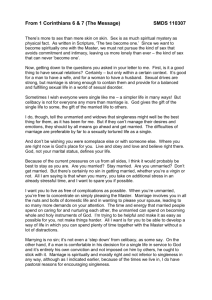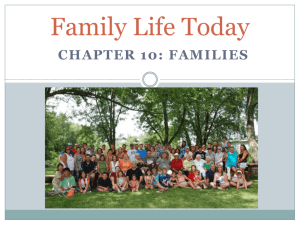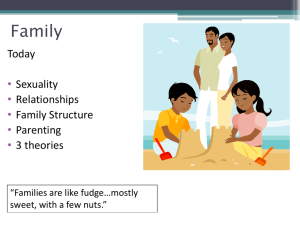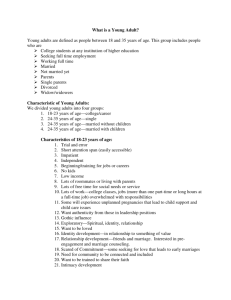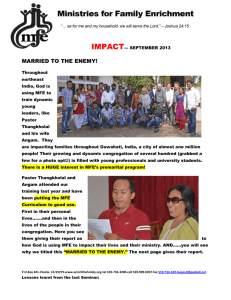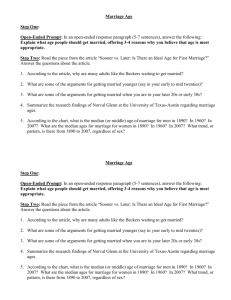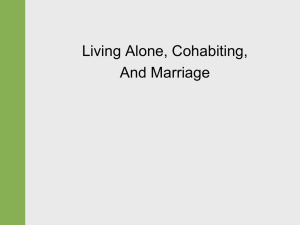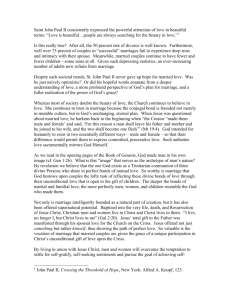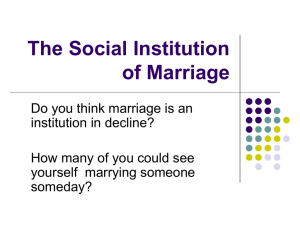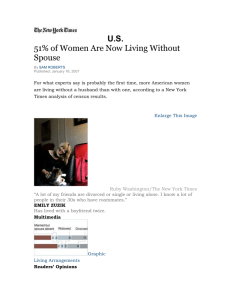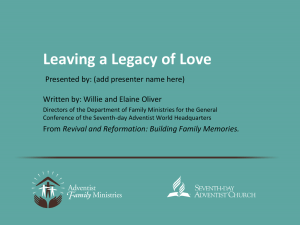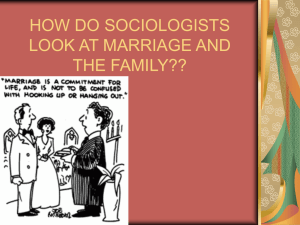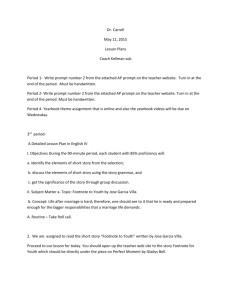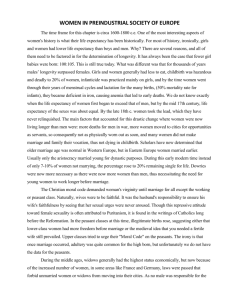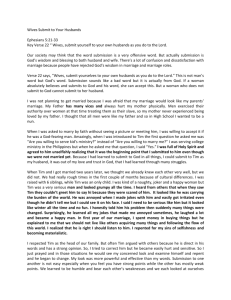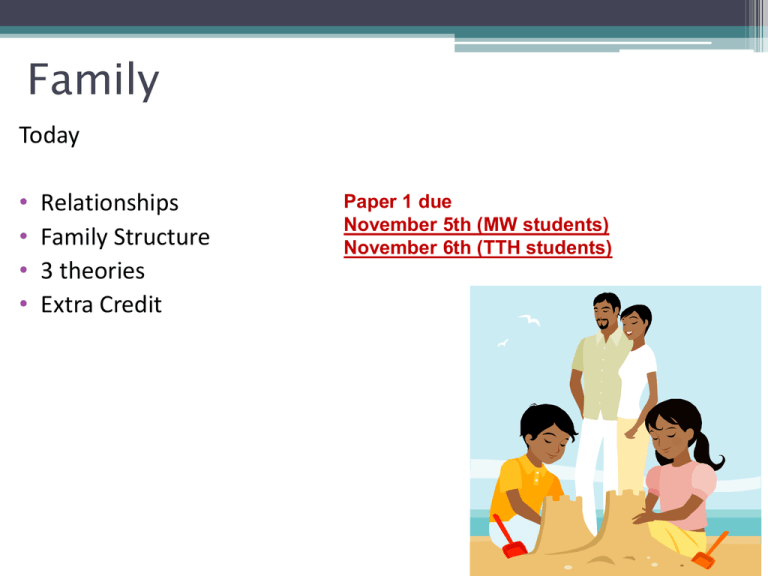
Family
Today
•
•
•
•
Relationships
Family Structure
3 theories
Extra Credit
Paper 1 due
November 5th (MW students)
November 6th (TTH students)
Finding your significant other
4 factors sociologists are interested in
1. Propinquity = spatial nearness
2. Homogamy: tendency
3. Heterogamy:
to chose a mate who is similar to
you
choosing a mate that is
different than you
hobbies, interests, education, personality, spending habits, age,
political beliefs…
4. Endogamy: choosing a
5. Exogamy:
mate of the same racial, ethnic, or
religious background
choosing a mate outside of
your race, ethnicity, religion
Extra Credit Reflection
Describe how you or someone you know (parents) found their
significant other (must be a long term relationship,2 years or more).
Describe propinquity, homogamy/heterogamy, endogamy/exogamy.
Which applied to the situation and how?
1-2 pages. 1 point. Due Oct 31/Nov 1
Defining Family
• Social institution found in every human society
• Two or more people, who consider themselves
related by blood, marriage, or adoption
Defining Family
• Nuclear family:
Parents and their
children
• Extended family:
parents, children,
other kin
What changes do you think have
occurred in the structure of families in
the United States since the 1950’s?
Has divorce increased, decreased,
or stayed the same since the
1980’s?
Number of divorces per 1,000 married women, age 15 and older
Source: The National Marriage Project, State of Our Unions, 2010.
Source: The National Marriage Project, State of Our Unions, 2010.
Pros and Cons of
Changes in Family Structure
Answer questions in groups of 1-3
Changes in structures of U.S. families:
1. Delayed childbearing
•Today 1 in 5 women are
having their first baby after
age 35
What are positive and
negative aspects of this
change?
Changes in U.S. family structures
2. Not having children
14% of U.S. married couples
never have children. Why?
•Expenses
•Career focus
•Unstable relationships
•Inability to have children
Changes in U.S. family structures
3. Increased employment of married mothers
59% of married U.S. couples
depend on two incomes
About one in five children is cared
for in day care centers. What are
positive and negative aspects of this
change?
Nannies have become popular
among upper-middle class parents.
What are positive and negative
aspects of this change?
Cosby Show
Changes in U.S. family structures
4. Increase in the number of
children being raised by
grandparents
According to the U.S. Census Bureau’s 2002 report, there are
more than 6.5 million children who are being raised by
grandparents or other relatives instead of by their parents.
What are positive and negative aspects of this change?
Changes in U.S. family structures
5. Increased divorce and blended families
Modern Family
Changes in U.S. family structures
6. Increased single-parent families
One on One
(Single dad and
teenage daughter)
Changes in U.S. family structures
7. Older age at 1st marriage
Friends
Sex and The City
Changes in structures of U.S. families:
Older age at 1st marriage
U.S. men and women are staying single longer
1970 average age at marriage
2006 average age at
marriage
Men: 23
Men : 28
Women: 21
Women: 26
Changes in U.S. family structures
8. Increased interracial families
The Willis Family from the
TV Show
The Jeffersons
Changes in U.S. family structures
9. Increased cohabitation-couple living
together that is not married
Grey’s Anatomy
Most unmarried partners: live in California, which accounts
for 1 out of 8 of such households in the country. Alaska is
number two.
Least unmarried partners: The states with the lowest
percentage of opposite-sex unmarried partners were Utah
at 4% and Alabama 5%
Changes in U.S. family structures
10. Less people getting married. Why?
1.Marriage must now compete with alternatives
such as
school
career
living with a partner
having children outside of marriage
self-fulfillment.
2. Most Americans still want to marry, but have less of a need to do so.
3. Most want children, but also value other uses of their time and money.
4. Many are indecisive about marriage, drawn by its promise of intimacy and
fearful of its commitments and constraints.
Other changes U.S. family structure
•
•
•
•
Increased births to unmarried women
Fewer children with married parents
Increase in families with same-sex parents
Increase in families with adopted children
Has teenage pregnancy increased,
decreased, or stayed the same
since 1990’s?
Source: Center for Disease Control and Prevention http://www.cdc.gov/nchs/products/hestats.htm
Structural Functionalist Perspective
Family is back bone of society:
– Replenishes population
– Socializes children
– Provides emotional and
physical care
– Traditional roles keep families
together
Conflict Perspective
Unequal power distribution in marriages
• Why do women take their husbands last name?
• Why do children take the father’s last name?
• Traditional roles require “domestic slavery” of the wife-no income
or status
• Even today working women still do
more of the housework
Symbolic Interactionist Perspective
Social meanings connected to divorce, single
parenthood, and cohabitation.
• “Visitation rights”
• “Single mom”
• “Living in sin”
Parenting: Discipline Techniques
1. Be a positive role model.
2. Set rules and consequences.
3. Encourage and reward good behavior.
4. Create charts.
5. Give time-outs.
6. Spanking
Which is best?
Which is worst?
Parenting
1. What did you underline and why
2. Do you agree with the author’s parenting style? Why or why not?
3. What parenting techniques do you think are best?
Chua family
From Ms. Chua's
album: 'Mean me with
Lulu in hotel room...
with score taped to
TV!'
Extra Credit
Take advantage of extra credit if:
• You do not participate in whole class discussions
• Did not score well on a test
• Did not turn in every assignment
• Have been late more than twice
• Have been absent more than twice
• Have texted in class
Extra Credit
Important Sociologists
• 5 minute Power Point Presentation
• Select a sociologist. Describe the following: brief background of their life,
2 major contributions to sociology, how is their work relevant today?
• 4 points possible
• Present next week
• Choose the sociologist in class today by signing up
View sample on website
Extra Credit
Extra Credit DVD Analysis Directions:
1. View any of the movies listed on website
2. Write 1-2 pages including:
a. Summary of the movie
b. Connection to sociology (what from class or text does it remind you of?)
c. Your personal reflection
1 point possible each. (*Remember 5 points of extra credit are the maximum for
the course, so you can do 5 movie reviews if you have no other extra credit)
Papers that earned 15/15:
1. Followed the scoring rubric provided on the website and discussed
in class
2. Answered the question with specific detailed examples (from
personal experience, research studies, history, news, world events)
3. Did not have errors in spelling, grammar, or punctuation
4. Demonstrated a strong understanding of the concept
5. Introduction had a strong, clear thesis previewing the 3 examples
From the paper rubric
Inclusion of
Personal
Analysis &
Sociological
Concepts
The author has taken the ideas and made them "his/her
own" by connecting them to personal experiences
and/or knowledge of world events.
All examples are specific and detailed.
Examples come from personal experience, news, or
history.
Examples are not general/hypothetical or the same as
those presented in class or in the text.
Weak body paragraph
Strong body paragraph. Example with specific details.
Robert Park refers to
the minority feeling
bonded to the culture
they came from. My
parents both apply to
this because they still
follow their cultural
ways.
Robert Park describes the assimilation experience for
three generations of immigrants. Park states that first
generation immigrants often hold on to many aspects of
their culture (class notes). This is true for my parents in
many ways. For example, it is a tradition in Japan for
people to take off their shoes before entering the home.
Even though we have lived in the United States since I
was four years old, my parents have always taught my
sisters and I to take our shoes off as soon as we come
home. We have a little bench right in our entry way just
for this purpose. Anyone who visits our home must also
take off their shoes. We do the same when visiting other
Japanese families as well.
Next class
Read Ch 11: p 265, 270-280
Coming up soon A#8 Due: Read the article
Misconceptions About Islam posted on the course website
and type half a page to one page describing your personal
reflection (What stood out to you most?)
5 points
Silent Dialogue Partner Activity
Purpose of the activity:
1. Develop critical thinking skills (there is no right or wrong answer,
no right or wrong question to pose). The goal is to ask your partner a
question that will invite them to look at their own thoughts in a
deeper manner
2. Allow shy/quiet students share their thoughts
3. Allow students to be the ones asking the questions instead of the
teacher
4. Allow students to get feedback from peers instead of the teacher
5. Allow the teacher to assess the background knowledge students
have on the topic (what do you already know about changes in family
structure?)
What changes do you think have occurred in the structure of families
in the United States since the 1950’s?
Partner activity
1. Answer the question above. Write NEATLY
Example: “One way I think families have changed since the 1950’s is ____”
2. When you hear the buzzer, pass your paper to your partner
3. Read their statement and write an OPEN-ENDED thought
provoking question for your partner that requires them to think
about the topic more deeply or look at it in a different way
4. When you hear the buzzer, switch papers and respond to you
partner’s question thoughtfully.
5. When you hear the buzzer switch papers and read the response
Write your names on both papers, turn into red folder at the end of class for your
participation points for today

